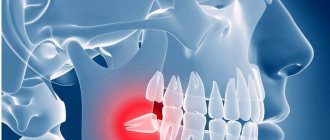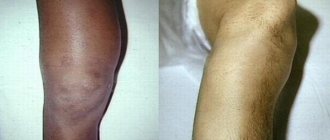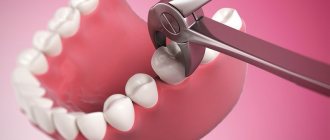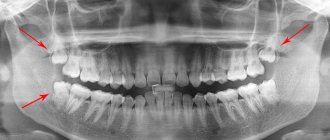Wisdom tooth extraction is a surgical procedure during which the third molar is removed from the dental socket.
This surgical intervention in uncomplicated cases is not particularly different from the removal of other teeth. The only thing that complicates it is the presence of a winding and long root system. The operation itself, with the exception of rare cases, is not a complex surgical procedure.
Wisdom teeth are considered rudiments, since they do not take part in the process of chewing food, due to changes in the diet of modern man.
They erupt at the age of 18 to 24 years. Previously, there were four of them in the jaw. Recently, cases have become increasingly common when molars are partially embedded or absent in the jaw altogether.
Cleaning them, due to their inaccessible location, is difficult. This contributes to the accumulation of plaque, which subsequently provokes the development of caries, damage to neighboring teeth, as well as various inflammatory processes in adjacent tissues.
Symptoms and signs for wisdom tooth removal
Symptoms that patients themselves complain about when problems with wisdom teeth occur:
- redness and swelling in the gum area;
- sharp or aching pain localized at the site of tooth eruption;
- the jaw opens poorly, the process is accompanied by nagging pain;
- feeling of discomfort when chewing food;
- bad breath;
- increased body temperature;
- painful swallowing.
If such symptoms occur, you must immediately consult a doctor who will conduct an examination, assess the situation and, if necessary, prescribe an x-ray.
Untimely treatment is fraught with aggravation of the situation, complicated by eruption or an inflammatory process in the area where the wisdom tooth is located. All this can lead to extensive abscess, phlegmon and osteomyelitis of the jaw.
Wisdom teeth - difference from other teeth
This tooth is no different from other molars in its structure. If it erupts without pain, does not cause discomfort to the person and has normal roots, then they do not get rid of it. Its cutting is often accompanied by acute or dull pain, lack of comfort when eating food and other unpleasant symptoms. The upper teeth can cause food stuck and damage to the mucous membrane, and the lower teeth can lead to the formation of a purulent hood, caries, etc.
The main differences are two factors:
- excessively curved or fused roots;
- the same curved root canals.
The first factor is reflected in the difficulty of extraction: the roots grow together and can have the most bizarre shapes. This is what causes the main difficulties for painless elimination. The second factor provokes difficulties with further treatment: canals of this shape are very difficult to subject to filling and mechanical stress.
Indications for wisdom tooth removal
There are a number of indications for wisdom tooth removal. Operations can be carried out planned or urgently.
Scheduled deletion
- Incorrect eruption. In this situation, the molars grow at an angle or horizontally. This can cause injury to the root system of teeth located nearby or to the gum tissue. In these cases, to preserve the chewing teeth, the wisdom tooth is removed.
- Cyst . The presence of a cyst near a wisdom tooth is an indication for its planned removal.
- Absence of an antagonist tooth . Also, a wisdom tooth is removed in cases where there is no “figure eight” on the opposite jaw. Because of this, a difference in pressure is created on the teeth, which is a risk of tooth protrusion.
- Caries . Often wisdom teeth emerge that are already affected by caries. These are the only teeth that no attempt is made to preserve in this disease. They are immediately removed.
- Partial or complete failure to erupt . A wisdom tooth embedded in the lower or upper jaw, but unerupted or not fully erupted, must also be removed.
- Inflammatory processes . Inflammation of wisdom teeth, due to their location, often spreads to the cheeks. A concomitant symptom is the formation of small ulcers on the mucous membrane around the tooth itself, followed by their growth.
Unscheduled surgery
Cases of immediate surgical intervention:
- severe wisdom tooth infection caused by a large abscess in the lower or upper jaw;
- tooth fractures due to mechanical impact.
Why remove wisdom teeth?
PHOTO: Extracted wisdom tooth. Please note: the roots spread in different directions, thanks to which the tooth is held very firmly in the jaw.
Removal of a wisdom tooth is resorted to in situations where, in the process of its development and eruption, it threatens the health of nearby healthy teeth, adversely affects the development of dental occlusion, or there is not enough space for eruption. When a wisdom tooth does not have enough space in the dentition, it begins to “push” adjacent teeth, which often causes malocclusion and the appearance of crowding of the front teeth in older age. A beautiful smile with evenly spaced teeth can be lost due to loose front teeth.
If infection and inflammation of the gums develop in the retromolar area, pain appears when opening the mouth and eating - it becomes difficult to open the mouth; The submandibular lymph nodes enlarge, body temperature rises. Inflammation of the gum mucosa may decrease and disappear, or an abscess (abscess) may develop, which will require emergency surgery and hospitalization. If a wisdom tooth constantly bothers you, the gum above it hurts (the hood of the mucous membrane), it must be removed.
Incorrect position of the third molar in the dentition is often the cause of the development of caries both on it and on the adjacent tooth. Treatment of wisdom teeth is difficult due to their remote location in the oral cavity and causes patients a lot of discomfort, as they have to sit for a long time with their mouth very wide open.
Contraindications to wisdom tooth removal
Removal of wisdom teeth has its contraindications. These include:
- acute infectious diseases, for example, pneumonia, tuberculosis, tonsillitis, etc.;
- strokes, heart attacks, ischemic attacks, hypertensive crises (if a similar condition was observed in the patient not so long ago, the removal of the wisdom tooth should be postponed until the condition normalizes);
- blood clotting disorder (the operation can be performed after certain preparation).
In most cases, wisdom teeth are not removed for pregnant women, since during this period the use of antibiotics and analgesics is limited (due to the risk to the fetus).
In what cases is deletion not required?
- The tooth erupts without causing discomfort, has the correct position and direction of growth.
- The wisdom tooth does not interfere with neighboring teeth, does not provoke their displacement or deformation.
- An overgrown extreme molar does not interfere with the installation of dental structures.
- In the case where the molar has a correctly erupted antagonist tooth.
- If treatment of the affected tooth is possible.
- The erupted wisdom tooth has the correct shape and does not injure the cheek and soft tissues of the oral cavity.
- Simply put, if the wisdom tooth has erupted safely and does not cause any trouble or discomfort, you should not touch it.
Even if a molar is affected by caries, but it is possible to cure it, the priority is treatment rather than extraction. The potential consequences and complications after removal are many times more complex than the treatment procedure.
When the figure eight is removed, inflammation, infection, and gumboil may develop, which will require complex and lengthy therapy. It is much easier and cheaper to cure caries or periodontitis that affects wisdom teeth.
Diagnostics before wisdom tooth removal
Before removing a wisdom tooth, the surgeon needs to see a complete and accurate picture of its location. This is especially true in cases where the tooth has not erupted.
The specialist must prescribe an x-ray or orthopantomogram.
Before the operation:
- inspection;
- taking anamnesis;
- analysis of the received images.
Possible complications after extraction
After removal of the extreme molar, patients experience swelling and swelling in the cheek and gum area, numbness of the face, moderate bleeding, discharge of ichor and pain. Moreover, these manifestations are companions of non-infectious inflammation and are considered the norm. They do not pose any danger and will disappear within a few days if the healing process is normal. The rehabilitation period after wisdom tooth removal lasts about one to two weeks.
More serious side effects should be expected if errors were made during the operation, or if the patient himself took the doctor’s recommendations lightly and violated the rules of rehabilitation.
A common complication after tooth extraction is osteomyelitis - an inflammatory lesion of bone and soft tissue. Suppuration begins inside the tissues. Osteomyelitis occurs if an infection gets into the socket during or after surgery. There is an increase in temperature, severe swelling of the gums and cheeks, severe persistent pain, general weakness, sleep disturbance and headaches.
Without medical intervention, infection and sepsis may spread.
Other consequences include abscess, paresthesia of the tongue, gumboil, and neuritis. All pathologies are accompanied by pain and deterioration in well-being. Therefore, if after one and a half, maximum two weeks, the pain, discomfort and swelling have not completely gone away, you should consult a dentist.
Wisdom tooth removal is a complex operation, and all risks should be carefully weighed before planning it. These teeth should be removed only if there are serious medical indications, and if there is an opportunity to save them, then it is worth taking advantage of it.
Treatment
Depending on the picture and accompanying symptoms, the process of wisdom tooth removal is conventionally divided into simple and complex.
Easy removal
The operation begins with the administration of anesthesia.
During removal, specialists use forceps and elevators. No incisions are made for this type of intervention. The process of extracting a tooth from bone tissue lasts 2 to 10 minutes, depending on the location of the roots.
The resulting wound is treated with an antiseptic. If it is large, stitches are placed to reduce the risk of infection in the wound. A bandage with an anesthetic is applied to the area of manipulation, this is done to reduce bleeding.
Difficult removal
In the case of a complex operation to remove wisdom teeth, the necessary data is also collected and analyzed, and anesthesia is administered.
The operation is accompanied by dissection of the gums with a scalpel. To remove the tooth itself, it is cut into pieces using a drill. This is done to make it easier to remove. After removal, the resulting wound is treated with an antiseptic and then sutured.
Depending on the location of the tooth, the operation can take from 15 minutes to an hour and a half.
After the manipulations, regardless of their complexity, the doctor must consult the patient on wound treatment and, if necessary, prescribe medication.
Removal using ultrasound
In some cases, and with the appropriate equipment, a tooth can be removed using an ultrasonic scalpel. It allows for contactless intervention. Wounds with these manipulations heal faster, and the risk of complications is reduced.
Excision of a dental pocket with preservation of the tooth
There is a disease of the wisdom tooth in which its removal is called into question. This is an inflammation of the dental pocket, which is caused by bacteria that get under the gums. With this pathology, the doctor dissects the hood without affecting the tooth itself. The area of inflammation is treated with antiseptics.
The process of tissue healing and restoration, as a rule, proceeds quickly and the need for removal disappears. If the so-called pericoronitis has reached the stage at which ulcers form on the mucous membrane, the wisdom tooth is removed.
Operation stages
In dentistry, there are 2 types of surgery to remove wisdom teeth. A simple option involves extracting the unit without making incisions in the gums or drilling out the roots. Only forceps and an elevator are used for removal. We can talk about simple removal in the absence of complications and deviations in the development of the tooth. Most often used for the upper jaw.
The second type of operation to remove “eights” is a complex type. The doctor will need a large number of instruments. This approach is used if we are talking about a badly damaged tooth or complex roots. Usually the lower “eights” are removed in this way.
Removing a wisdom tooth is a complex surgical procedure that requires preliminary preparation. The main danger of a professional procedure is the violation of the integrity of the part of the bone adjacent to the gum, therefore, in order to avoid infection of the surgical wound, the oral cavity must be healthy. Manipulations are performed under local anesthesia - it is necessary to warn the dentist about any allergic reaction to the drugs used:
- diagnostics
. Before removal, an examination and x-ray examination are carried out to form a clinical picture and study the structural features and localization of the third molar - the extraction technique directly depends on the data obtained on x-ray images; - anesthesia
. Modern drugs of the articaine group are used, which are produced for carpule anesthesia: a carpule with an anesthetic solution and adrenaline is charged into a syringe, and a painless injection is performed. After adequate anesthesia, wisdom tooth removal is painless; - The gums are peeled off
using a special tool, the doctor loosens the organ, holding it with forceps, removes it, and removes bone fragments. After the tooth is removed, the doctor treats the hole with antiseptics, puts an anti-inflammatory solution into it, and sutures the wound. When extirpating dystopic/impacted units, the surgeon makes an incision in the gum, folds back the mucoperiosteal flap (hood), drills a hole in the bone with a drill, extracts the tooth, puts an anti-inflammatory agent into the cavity, and applies sutures.
In modern dental clinics, in addition to the classical options for surgery to remove wisdom teeth, special equipment is used - an ultrasonic scalpel. This technology reduces the procedure time and also ensures rapid wound healing. Ultrasonic removal of wisdom teeth is performed under anesthesia.
The period after wisdom tooth removal
Based on the patient’s condition, the doctor can prescribe antibacterial therapy 9 both locally and orally). To relieve toothache and generally normalize your health, painkillers may be prescribed. It is also possible to take medications that reduce fever.
After the operation, the doctor may additionally prescribe physiotherapeutic procedures using ultrasound. After them, swelling and inflammation decrease, which leads to the disappearance of painful sensations.
After the operation, it is necessary to exclude any thermal exposure: do not drink hot water and drinks, do not take a bath or other procedures that promote vasodilation.
The gauze pad that the specialist places on the wound must be removed after 20 minutes.
Eating is prohibited for several hours after tooth extraction.
You cannot rinse the socket intensively so as not to wash out the blood clot, as it promotes tissue fusion.
You should not use your tongue, brush, dental floss, toothpick, etc., into the hole formed after tooth extraction.
In case of severe swelling and pain, ice is applied to the side where the tooth was removed.
Rehabilitation period
There will be no pain during the removal procedures; they arise after the intervention. Their intensity depends on the complexity of the procedure: removal of the upper “eights” is easier, the lower ones are more difficult to remove due to the high bone density, so the recovery period is more difficult. Soreness and swelling develops 1-2 hours after the extraction procedure, gradually increases over three days, then decreases and subsides after 10-14 days.
Until the wound has healed, all doctor’s recommendations should be followed during the postoperative period. You should refrain from drinking hot food/drinks and protect them from contact with the toothbrush. For several days after the operation, it is recommended to give up smoking, drinking alcohol, physical activity, and hot water procedures, which provoke an increase in blood pressure, which can lead to delayed bleeding. Due to the anatomy of wisdom teeth, after their removal, a situation such as swelling of the facial tissue/gingiva often arises - you cannot heat it, after a week the swelling subsides spontaneously.
Paresthesia (numbness) of the working area disappears spontaneously after 4-6 hours and does not require special therapy.
When the third molars are adequately positioned and healthy, it is best to leave them alone. Prophylactic extraction has not proven itself in practice.
Indications for treatment
:
- the need for prosthetics in the absence of “seven”, “six” and “eight”;
- there is an antagonist;
- the unit takes part in chewing;
- occupies the correct position in the row.










